|
|
|---|
Thursday, January 6, 2011
Life-Water-Viking Experiments On Mars and It's climate structure Composition
Posted by pece at 2:44 AMMars Exploration Program Planet Mission and It's Physical characteristics-
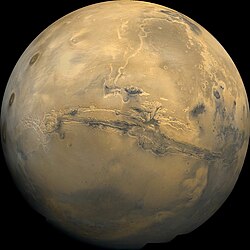 Mars in 1980 as seen by the Viking 1 Orbiter | ||||||||||
Designations | ||||||||||
|---|---|---|---|---|---|---|---|---|---|---|
| Pronunciation | /ˈmɑrz/ | |||||||||
| Adjective | Martian | |||||||||
Orbital characteristics | ||||||||||
| Epoch J2000 | ||||||||||
| Aphelion | 249,209,300 km 1.665 861 AU | |||||||||
| Perihelion | 206,669,000 km 1.381 497 AU | |||||||||
| Semi-major axis | 227,939,100 km 1.523 679 AU | |||||||||
| Eccentricity | 0.093 315 | |||||||||
| Orbital period | 686.971 days 1.8808 Julian years 668.5991 sols | |||||||||
| Synodic period | 779.96 days 2.135 Julian years | |||||||||
| Average orbital speed | 24.077 km/s | |||||||||
| Mean anomaly | 19.3564° | |||||||||
| Inclination | 1.850° to ecliptic 5.65° to Sun's equator 1.67° to invariable plane | |||||||||
| Longitude of ascending node | 49.562° | |||||||||
| Argument of perihelion | 286.537° | |||||||||
| Satellites | 2 | |||||||||
Physical characteristics | ||||||||||
| Equatorial radius | 3,396.2 ± 0.1 km 0.533 Earths | |||||||||
| Polar radius | 3,376.2 ± 0.1 km 0.531 Earths | |||||||||
| Flattening | 0.005 89 ± 0.000 15 | |||||||||
| Surface area | 144,798,500 km2 0.284 Earths | |||||||||
| Volume | 1.6318×1011 km3 0.151 Earths | |||||||||
| Mass | 6.4185×1023 kg 0.107 Earths | |||||||||
| Mean density | 3.9335 ± 0.0004 g/cm³ | |||||||||
| Equatorial surface gravity | 3.711 m/s² 0.376 g | |||||||||
| Escape velocity | 5.027 km/s | |||||||||
| Sidereal rotation period | 1.025 957 day 24.622 9 h | |||||||||
| Equatorial rotation velocity | 868.22 km/h (241.17 m/s) | |||||||||
| Axial tilt | 25.19° | |||||||||
| North pole right ascension | 21 h 10 min 44 s 317.681 43° | |||||||||
| North pole declination | 52.886 50° | |||||||||
| Albedo | 0.170 (geometric) 0.25 (Bond) | |||||||||
| Surface temp. Kelvin Celsius |
| |||||||||
| Apparent magnitude | +1.6 to −3.0 | |||||||||
| Angular diameter | 3.5–25.1" | |||||||||
Atmosphere | ||||||||||
| Surface pressure | 0.636 (0.4–0.87) kPa | |||||||||
| Composition | 95.32% carbon dioxide 2.7% nitrogen 1.6% argon 0.13% oxygen 0.08% carbon monoxide 210 ppm water vapor 100 ppm nitric oxide 15 ppm molecular hydrogen 2.5 ppm Neon 850 ppb HDO 300 ppb Krypton 130 ppb formaldehyde 80 ppb xenon 30 ppb ozone 18 ppb hydrogen peroxide 10 ppb methane | |||||||||
Mars is the fourth planet from the Sun in the Solar System. The planet is named after the Roman god of war, Mars. It is often described as the "Red Planet", as the iron oxide prevalent on its surface gives it a reddish appearance. Mars is a terrestrial planet with a thin atmosphere, having surface features reminiscent both of the impact craters of the Moon and the volcanoes, valleys, deserts, and polar ice caps of Earth. The rotational period and seasonal cycles of Mars are likewise similar to those of Earth. Mars is the site of Olympus Mons, the highest known mountain within the Solar System, and of Valles Marineris, the largest canyon. The smooth Borealis basin in the northern hemisphere covers 40% of the planet and may be a giant impact feature.
Until the first flyby of Mars occurred in 1965, by Mariner 4, many speculated about the presence of liquid water on the planet's surface. This was based on observed periodic variations in light and dark patches, particularly in the polar latitudes, which appeared to be seas and continents; long, dark striations were interpreted by some as irrigation channels for liquid water. These straight line features were later explained as optical illusions, yet of all the planets in the Solar System other than Earth, Mars is the most likely to harbor liquid water, and thus to harbor life. Geological evidence gathered by unmanned missions suggest that Mars once had large-scale water coverage on its surface, while small geyser-like water flows may have occurred during the past decade. In 2005, radar data revealed the presence of large quantities of water ice at the poles, The and at mid-latitudes.Phoenix lander directly sampled water ice in shallow Martian soil on July 31, 2008.
Mars has two moons, Phobos and Deimos, which are small and irregularly shaped. These may be captured asteroids, similar to 5261 Eureka, a Martian Trojan asteroid. Mars is currently host to three functional orbiting spacecraft: Mars Odyssey, Mars Express, and the Mars Reconnaissance Orbiter. On the surface are the two Mars Exploration Rovers (Spirit and Opportunity) and several inert landers and rovers, both successful and unsuccessful. The Phoenix lander completed its mission on the surface in 2008. Observations by NASA's now-defunct Mars Global Surveyor show evidence that parts of the southern polar ice cap have been receding.
Mars can easily be seen from Earth with the naked eye. Its apparent magnitude reaches −3.0 a brightness surpassed only by Venus, the Moon, and the Sun.
Water on Mars-
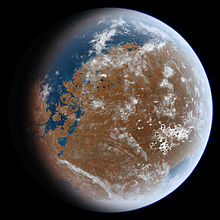
An artist's impression of what ancient Mars may have looked like, based on geological data.
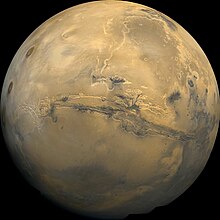
Mars now
(Viking)
(Viking)
Water on Mars is much less abundant than it is on Earth, in all three states of matter. Most of the water is locked in the cryosphere (permafrost and polar caps), so there are no bodies of liquid water which could create a hydrosphere. Only a small amount of water vapour is in the atmosphere.
Current conditions on the planet surface do not support the long-term existence of liquid water. The average pressure and temperature are far too low, leading to immediate freezing and resulting sublimation. Despite this, research suggests that in the past there was liquid water flowing on the surface, creating large areas similar to Earth's oceans. However, the question remains as to where the water has gone.
There are a number of direct and indirect proofs of water's presence either on or under the surface, e.g. stream beds, polar caps, spectroscopic measurement, eroded craters or minerals directly connected to the existence of liquid water (such as goethite). In an article in the Journal of Geophysical Research, scientists studied Lake Vostok in Antarctica and discovered that it may have implications for liquid water still being on Mars. Through their research, scientists came to the conclusion that if Lake Vostok existed before the perennial glaciation began, that it is likely that the lake did not freeze all the way to the bottom. Due to this hypothesis, scientists say that if water had existed before the polar ice caps on Mars, it is likely that there is still liquid water below the ice caps.
Film and television-
- The Angry Red Planet (or Invasion of Mars and Journey to Planet Four), a 1959 science fiction film
- Commander Mars, one of the Galactic Commanders from Pokémon
- Mars or Scarface (Kinnikuman), a dMp choujin from Ultimate Muscle
- Mars (1997 film), a 1997 movie starring Shari Belafonte
- Mars (2004 film), a 2004 Russian film
- Mars (2010 film), a 2010 American film
- Mars (actor), member of the Jackie Chan Stunt Team
- Mars the Dog, canine star of A Dog's Breakfast
- Mars (Biker Mice from Mars), the planet as it appears in the cartoon series
Literature-
- Mars, a novel by Ben Bova in the Grand Tour series
- Mars trilogy, three science fiction novels by Kim Stanley Robinson
- Mars (Fritz Zorn), an autobiographical essay by Fritz Angst
- Mars (manga), a 1996 manga series by Fuyumi Soryo
- Mars (Mitsuteru Yokoyama), a 1976 manga series by Mitsuteru Yokoyama
- The Megaversity Association for Reenactments and Simulations, in Neal Stephenson's novel The Big U
- Mars in fiction
Physical characteristics-
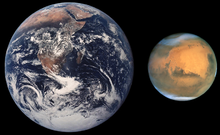
Size comparison of Earth and Mars.

The "face on Mars"
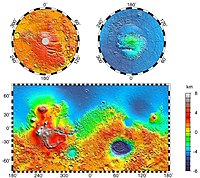
Volcanic plateaus (red) and impact basins (blue) dominate this topographic map of Mars

Rock strewn surface imaged by Mars Pathfinder
Mars has approximately half the radius of Earth. It is less dense than Earth, having about 15% of Earth's volume and 11% of the mass. Its surface area is only slightly less than the total area of Earth's dry land. While Mars is larger and more massive than Mercury, Mercury has a higher density. This results in the two planets having a nearly identical gravitational pull at the surface—that of Mars is stronger by less than 1%. Mars is also roughly intermediate in size, mass, and surface gravity between Earth and Earth's Moon (the Moon is about half the diameter of Mars, whereas Earth is twice; the Earth is about nine times more massive than Mars, and the Moon one-ninth as massive). The red-orange appearance of the Martian surface is caused by iron(III) oxide, more commonly known as hematite, or rust.
Geology-
Based on orbital observations and the examination of the Martian meteorite collection, the surface of Mars appears to be composed primarily of basalt. Some evidence suggests that a portion of the Martian surface is more silica-rich than typical basalt, and may be similar to andesitic rocks on Earth; however, these observations may also be explained by silica glass. Much of the surface is deeply covered by finely grained iron(III) oxide dust.
Although Mars has no evidence of a current structured global magnetic field, observations show that parts of the planet's crust have been magnetized, and that alternating polarity reversals of its dipole field have occurred in the past. This paleomagnetism of magnetically susceptible minerals has properties that are very similar to the alternating bands found on the ocean floors of Earth. One theory, published in 1999 and re-examined in October 2005 (with the help of the Mars Global Surveyor), is that these bands demonstrate plate tectonics on Mars four billion years ago, before the planetary dynamo ceased to function and caused the planet's magnetic field to fade away.
Current models of the planet's interior imply a core region about 1,480 km in radius, consisting primarily of iron with about 14–17% sulfur. This iron sulfide core is partially fluid, and has twice the concentration of the lighter elements than exist at Earth's core. The core is surrounded by a silicate mantle that formed many of the tectonic and volcanic features on the planet, but now appears to be inactive. The average thickness of the planet's crust is about 50 km, with a maximum thickness of 125 km. Earth's crust, averaging 40 km, is only one third as thick as Mars’ crust, relative to the sizes of the two planets.
During the Solar system formation, Mars was created out of the protoplanetary disk that orbited the Sun as the result of a stochastic process of run-away accretion. Mars has many distinctive chemical features caused by its position in the Solar System. Elements with comparatively low boiling points such as chlorine, phosphorus and sulphur are much more common on Mars than Earth; these elements were probably removed from areas closer to the Sun by the young Sun's powerful solar wind.
After the formation of the planets, all were subjected to the "Late Heavy Bombardment". About 60% of the surface of Mars shows an impact record from that era. Much of the rest of the surface of Mars is probably underlain by immense impact basins that date from this time—there is evidence of an enormous impact basin in the northern hemisphere of Mars, spanning 10,600 km by 8,500 km, or roughly four times larger than the Moon's South Pole-Aitken basin, the largest impact basin yet discovered. This theory suggests that Mars was struck by a Pluto-sized body about four billion years ago. The event, thought to be the cause of the Martian hemispheric dichotomy, created the smooth Borealis basin that covers 40% of the planet.
Atmosphere of Mars-
 | |
| Carbon dioxide | 95.32% |
| Nitrogen | 2.7% |
| Argon | 1.6% |
| Oxygen | 0.13% |
| Carbon monoxide | 0.07% |
| Water vapor | 0.03% |
| Nitric oxide | 0.013% |
| Neon | 2.5 ppm |
| Krypton | 300 ppb |
| Formaldehyde | 130 ppb |
| Xenon | 80 ppb |
| Ozone | 30 ppb |
| Methane | 10.5 ppb |
Mars, the 4th planet from the Sun, has a very different atmosphere from that of the Earth. There has been much interest in studying its composition since the recent detection of trace amounts of methane, which may indicate the presence of life on Mars; its presence could also be caused by a geochemical process, or it could be the result of volcanic or hydrothermal activity.
The atmosphere of Mars is relatively thin, and the atmospheric pressure on the surface varies from around 30 pascals (0.0044 psi) on Olympus Mons's peak to over 1,155 pascals (0.1675 psi) in the depths of Hellas Planitia, with a mean surface level pressure of 600 pascals (0.087 psi), compared to Earth's sea level average of 101.3 kilopascals (14.69 psi), and a total mass of 25 teratonnes, compared to Earth's 5148 teratonnes. However, the scale height of the atmosphere is about 11 kilometers (6.8 mi), somewhat higher than Earth's 7 kilometers (4.3 mi). The atmosphere on Mars consists of 95% carbon dioxide, 3% nitrogen, 1.6% argon, and contains traces of oxygen, water, and methane, for a mean molecular weight of 43.34 g/mole. The atmosphere is quite dusty, giving the Martian sky a light brown or orange color when seen from the surface; data from the Mars Exploration Rovers indicate that suspended dust particles within the atmosphere are roughly 1.5 micrometers across.
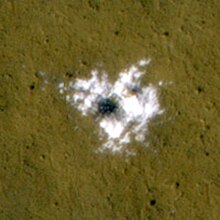
Bright part is water ice that has been exposed by impact. The ice was identified using CRISM on the MRO. Location is Cebrenia quadrangle.
Research, reported in the journal Science in September 2009, This discovery proves that future colonists on Mars will be able to obtain water from a wide variety of locations. The ice can be dug up, melted, then taken apart to provide fresh oxygen and hydrogen for rocket fuel. Hydrogen is the powerful fuel used by the space shuttle main engines. demonstrated that some new craters on Mars show exposed, pure, water ice. After a time, the ice disappears, evaporating into the atomsphere. The ice is only a few feet deep. The ice was confirmed with the Compact Imaging Spectrometer (CRISM) onboard the Mars Reconnaissance Orbiter (MRO). The ice was found in a total of 5 locations. Three of the locations are in the Cebrenia quadrangle. These locations are 55.57° N, 150.62° E; 43.28° N, 176.9° E; and 45° N, 164.5° E. Two others are in the Diacria quadrangle: 46.7° N, 176.8° E and 46.33° N, 176.9° E.
The European Space Agency (ESA) found that the concentrations of methane in the martian atmosphere were not even, but coincided with the presence of water vapor. In the upper atmosphere these two gasses are uniformly distributed, but near the surface they concentrate in three equatorial regions, namely Arabia Terra, Elysium Planitia, and Arcadia Memnonia. Planetary scientist David H. Grinspoon (Southwest Research Institute) feels the coincidence of water vapor and methane increases the chance of a biological source, but cautions that it is uncertain how life could have survived so long on a planet as inhospitable as Mars, although it has been suggested that caves may be the only natural structures capable of protecting primitive life forms from micrometeoroids, UV radiation, solar flares and high energy particles that bombard the planet's surface.
Ultimately, to rule out a biogenic origin for the methane, a future probe or lander hosting a mass spectrometer will be needed, since the isotopic proportions of carbon-12 to carbon-14 in methane could distinguish between a biogenic and non-biogenic origin. However, efforts to identify the sources of terrestrial methane have found that measurements of methane (CH4) isotopologues do not necessarily distinguish between possible geologic and biogenic sources, and it has been found that the abundances of other cogenerated gas, such as ethane (C2H6), relative to methane can distinguish between a source from active biology and other potential sources; the ethane/methane abundance ratio is <10-3 for the former, while other sources produce nearly equivalent amounts of methane and ethane.
In 2012, the Mars Science Laboratory rover will measure such isotopes. If microscopic Martian life is producing the methane, it likely resides far below the surface, where it is still warm enough for liquid water to exist. NASA has revealed the goal of launching the Mars Trace Gas Mission orbiter on 2016 to further study the methane, as well as its decomposition products such as formaldehyde and methanol.
History-
Mars' atmosphere is believed to have changed over the course of the planet's lifetime, with evidence suggesting the possibility that Mars had large oceans a few billion years ago. As stated in the Mars Ocean Hypothesis, atmospheric pressure on the present day Martian surface only exceeds that of the triple point of water (6.11 hectopascals (0.0886 psi)) in the lowest elevations; at higher elevations water can exist only in solid or vapor form. Annual mean temperatures at the surface are currently less than 210 K (−63 °C; −82 °F), significantly less than what is needed to sustain liquid water. However, early in its history Mars may have had conditions more conducive to retaining liquid water at the surface.
Possible causes for the depletion of a previously thicker martian atmosphere include:
- Catastrophic collision by a body large enough to blow away a significant percentage of the atmosphere;
- Gradual erosion of the atmosphere by solar wind; and
- On-going removal of atmosphere due to electromagnetic field and solar wind interaction.

Sunset on Mars.
Composition-
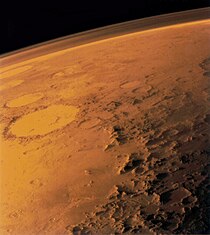
Mars' thin atmosphere, visible on the horizon in this low orbit image.
Carbon dioxide-
The main component of the atmosphere of Mars is carbon dioxide (CO2). During the Martian winter the poles are in continual darkness and the surface gets so cold that as much as 25% of the atmospheric CO22 ice (dry ice). When the poles are again exposed to sunlight during the Martian summer, the CO2 ice sublimates back into the atmosphere. This process leads to a significant annual variation in the atmospheric pressure and atmospheric composition around the Martian poles. condenses at the polar caps into solid CO
Argon-
The atmosphere of Mars is enriched considerably with the noble gas argon, in comparison to the atmosphere of the other planets within the Solar System. Unlike carbon dioxide, the argon content of the atmosphere does not condense, and hence the total amount of argon in the Mars atmosphere is constant. However, the relative concentration at any given location can change as carbon dioxide moves in and out of the atmosphere. Recent satellite data shows an increase in atmospheric argon over the southern pole during its autumn, which dissipates the following spring.
Terraforming of Mars-

Artist's conception of the process of terraforming Mars.
The terraforming of Mars is the hypothetical process by which the climate, surface, and known properties of Mars would be deliberately changed with the goal of making it habitable by humans and other terrestrial life, thus providing the possibility of safe and sustainable colonization of large areas of the planet.
The concept is reliant on the assumption that the environment of a planet can be altered through man-made means; the feasibility of creating an unconstrained planetary biosphere is undetermined. There are several proposed methods, some of which present economic and natural resources do not allow, and others which are currently technologically achievable.
Changes required-
| Mars | Earth | |
|---|---|---|
| Pressure | 0.6 kPa (0.087 psi) | 101.3 kPa (14.69 psi) |
| Carbon dioxide (CO2) | 95.32% | 0.04% |
| Nitrogen (N2) | 2.70% | 78.08% |
| Argon (Ar) | 1.60% | 0.93% |
| Oxygen (O2) | 0.13% | 20.94% |
Terraforming Mars would entail three major interlaced changes: building up the atmosphere, keeping it warm, and keeping the atmosphere from being lost into outer space. The atmosphere of Mars is relatively thin and thus has a very low surface pressure of 0.6 kilopascals (0.087 psi); compared to Earth with 101.3 kilopascals (14.69 psi) at sea level and 0.86 kilopascals (0.125 psi) at an altitude of 32 kilometres (20 mi). The atmosphere on Mars consists of 95% carbon dioxide (CO2), 3% nitrogen, 1.6% argon, and contains only traces of oxygen, water, and methane. Since its atmosphere consists mainly of CO2, a known greenhouse gas, once the planet begins to heat, more CO2 enters the atmosphere from the frozen reserves on the poles, adding to the greenhouse effect. This means that the two processes of building the atmosphere and heating it would augment one another, favoring terraforming. However, on a large scale, controlled application of certain techniques (explained below) over enough time to achieve sustainable changes would be required to make this hypothesis a reality.
Travelers of the Future, Beware! Mars is no place for the faint-hearted. Arid, rocky, cold and apparently lifeless, the Red Planet offers few hospitalities. Fans of extreme sports can rejoice, however, for the Red Planet will challenge even the hardiest souls among us. Home to the largest volcano in the solar system, the deepest canyon and crazy weather and temperature patterns, Mars looms as the ultimate lonely planet destination.
Climate of Mars-

Mosaic image of Mars as seen by Viking 1, 22 February 1980
The climate of Mars has been an issue of scientific curiosity for centuries, not least because Mars is the only terrestrial planet whose surface can be directly observed in detail from the Earth.
Although Mars is smaller (11% by mass) and 50% farther from the Sun than the Earth, its climate has important similarities, such as the polar ice caps, seasonal changes and the observable presence of weather patterns. It has attracted sustained study from planetologists and climatologists. Although Mars's climate has similarities to Earth's, including seasons and periodic ice ages, there are also important differences such as the absence of liquid water (though frozen water exists) and much lower thermal inertia. Mars' atmosphere has a scale height of approximately 11 km (36,000 ft), 60% greater than that on Earth. The climate is of considerable relevance to the question of whether life is or was present on the planet, and briefly received more interest in the news due to NASA measurements indicating increased sublimation of the south polar icecap leading to some popular press speculation that Mars was undergoing a parallel bout of global warming.
Mars has been studied by Earth-based instruments since as early as the 17th century but it is only since the exploration of Mars began in the mid-1960s that close-range observation has been possible. Flyby and orbital spacecraft have provided data from above, while direct measurements of atmospheric conditions have been provided by a number of landers and rovers. Advanced Earth orbital instruments today continue to provide some useful "big picture" observations of relatively large weather phenomena.
Clouds-
| This section requires expansion. |

Animation of ice clouds moving above the Phoenix landing site over a period of ten minutes.
Mars' dust storms can kick up fine particles in the atmosphere around which clouds can form. These clouds can form very high up, up to 62 miles above the planet. The clouds are very faint and can only be seen reflecting sunlight against the darkness of the night sky. In that respect, they look similar to the mesospheric clouds, also known as noctilucent clouds on Earth, which occur about 50 miles (80 kilometers) above our planet.
The Phoenix Mars lander from NASA, which landed in the Mars Arctic plain in May 2008, confirmed the presence of frozen water near the surface. This was confirmed when bright material, exposed by the digging arm of the lander, was found to have vaporized and disappeared in 3 to 4 days. This has been attributed to sub-surface ice, exposed by the digging and sublimated on exposure to the atmosphere.
Scientists have long speculated about the possibility of life on Mars owing to the planet's proximity and similarity to Earth. Although fictional Martians have been a recurring feature of popular entertainment, it remains an open question whether life currently exists on Mars, or has existed there in the past.
Viking landers-

Carl Sagan with a model of the Viking Lander, to scale (NASA).
The total cost of the Viking project was roughly US$1 billion. The lander consisted of a six-sided aluminum base with alternate 1.09 m (3 ft 7 in) and 0.56 m (1 ft 10 in) long sides, supported on three extended legs attached to the shorter sides. The leg footpads formed the vertices of an equilateral triangle with 2.21 m (7 ft 3 in) sides when viewed from above, with the long sides of the base forming a straight line with the two adjoining footpads.
Instrumentation was attached to the top of the base, elevated above the surface by the extended legs. Power was provided by two radioisotope thermal generator (RTG) units containing plutonium-238 affixed to opposite sides of the lander base and covered by wind screens. Each generator was 28 cm (11 in) tall, 58 cm (23 in) in diameter, had a mass of 13.6 kg (30 lb) and provided 30 watts continuous power at 4.4 volts. Four wet cell sealed nickel-cadmium 8 ampere-hours (28,800 Coulombs), 28 volts rechargeable batteries were also onboard to handle peak power loads.

Mars from the Viking Orbiter.
Propulsion for deorbit was provided by a monopropellant called hydrazine (N2H4), through a rocket with 12 nozzles arranged in four clusters of three that provided 32 newtons (7.2 lbf) thrust, providing a delta-V of 180 m/s (590 ft/s). These nozzles also acted as the control thrusters for translation and rotation of the lander. Terminal descent and landing utilized three (one affixed on each long side of the base, separated by 120 degrees) monopropellant hydrazine engines. The engines had 18 nozzles to disperse the exhaust and minimize effects on the ground, and were throttleable from 276 to 2,667 newtons (62 to 600 lbf). The hydrazine was purified in order to prevent contamination of the Martian surface with Earth microbes.
The lander carried 85 kg (190 lb) of propellant at launch, contained in two spherical titanium tanks mounted on opposite sides of the lander beneath the RTG windscreens, giving a total launch mass of 657 kg (1,450 lb). Control was achieved through the use of an inertial reference unit, four gyros, a parachute, a radar altimeter, a terminal descent and landing radar, and the control thrusters.
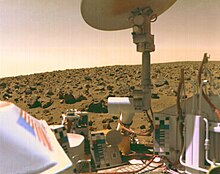
Image from Mars taken by Viking 2.
Each lander was covered over from launch until Martian atmospheric entry with an aeroshell heat shield designed to slow the lander down during the entry phase, and also to prevent contamination of the Martian surface with Earthly microbial life that can survive the harsh conditions of deep space (as evident on the Surveyor 3 moon probe). As a further precaution, each lander, upon assembly and enclosure within the aeroshell, were "baked" at a temperature of 250 °F (121 °C) for a total of seven days, after which a "bioshield" was then placed over the aeroshell that was jettisoned after the Centaur upper stage fired the Viking orbiter/lander combination out of Earth orbit. The methods and standards developed for planetary protection for the Viking mission are still used for other missions.
Communications were accomplished through a 20 watt S-band transmitter using two traveling-wave tubes. A two-axis steerable high-gain parabolic antenna was mounted on a boom near one edge of the lander base. An omnidirectional low-gain S-band antenna also extended from the base. Both these antennae allowed for communication directly with the Earth, permitting Viking 1 to continue to work long after both orbiters had failed. A UHF (381 MHz) antenna provided a one-way relay to the orbiter using a 30 watt relay radio. Data storage was on a 40-Mbit tape recorder, and the lander computer had a 6000-word memory for command instructions.
The lander carried instruments to achieve the primary scientific objectives of the lander mission: to study the biology, chemical composition (organic and inorganic), meteorology, seismology, magnetic properties, appearance, and physical properties of the Martian surface and atmosphere. Two 360-degree cylindrical scan cameras were mounted near one long side of the base. From the center of this side extended the sampler arm, with a collector head, temperature sensor, and magnet on the end.
A meteorology boom, holding temperature, wind direction, and wind velocity sensors extended out and up from the top of one of the lander legs. A seismometer, magnet and camera test targets, and magnifying mirror are mounted opposite the cameras, near the high-gain antenna. An interior environmentally controlled compartment held the biology experiment and the gas chromatograph mass spectrometer. The X-ray fluorescence spectrometer was also mounted within the structure. A pressure sensor was attached under the lander body. The scientific payload had a total mass of approximately 91 kg (200 lb).
From Wikipedia-
0 Comments:
Subscribe to:
Post Comments (Atom)















